T he present book describes the developmental trajectory of Iranian arms and armor through the centuries. The Iranian epics such as Shahname are full of stories about ancient heroes who fought for the just cause and destroyed the forces of Ahriman. The legendary figure of Rostam, from Shahname, has served as a role model of a pahlavan, a hero who supported the Iranian kings and fought against injustice, for countless generations of Iranian kings and warriors. The weapons used by these heroes are meticulously described in the Shahname. The holy book of the Avesta, sacred to the Zoroastrians, also names many types of arms and armor and describes each of them in detail. Various archeological excavations in the northern regions of Iran, such as those in Gilan, and archeological excavations
he present book describes the developmental trajectory of Iranian arms and armor through the centuries. The Iranian epics such as Shahname are full of stories about ancient heroes who fought for the just cause and destroyed the forces of Ahriman. The legendary figure of Rostam, from Shahname, has served as a role model of a pahlavan, a hero who supported the Iranian kings and fought against injustice, for countless generations of Iranian kings and warriors. The weapons used by these heroes are meticulously described in the Shahname. The holy book of the Avesta, sacred to the Zoroastrians, also names many types of arms and armor and describes each of them in detail. Various archeological excavations in the northern regions of Iran, such as those in Gilan, and archeological excavations  and illegal digs in southwestern areas, such as Luristan, have revealed a tremendous number and variety of bronze weaponry, such as bronze daggers and swords, and some pieces of armor. This book exhibits a number of selected bronze daggers and swords that were excavated by Dr. Ezat Negahban in Marlik, as well as an array of bronze weapons from Luristan that is currently kept in the National Museum of Iran in Tehran. These bronze weapon
and illegal digs in southwestern areas, such as Luristan, have revealed a tremendous number and variety of bronze weaponry, such as bronze daggers and swords, and some pieces of armor. This book exhibits a number of selected bronze daggers and swords that were excavated by Dr. Ezat Negahban in Marlik, as well as an array of bronze weapons from Luristan that is currently kept in the National Museum of Iran in Tehran. These bronze weapon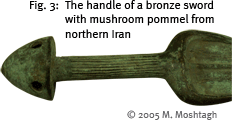 s show a variety of manufacturing techniques that utilized very advanced technology, such as one-mold casting, cast-on technique and cire perdu (the lost wax process). This book contains an accurate and detailed description of all these techniques, along with breathtaking pictures of bronze weapons that accompany the text to give the readers a good grasp of the topic.
s show a variety of manufacturing techniques that utilized very advanced technology, such as one-mold casting, cast-on technique and cire perdu (the lost wax process). This book contains an accurate and detailed description of all these techniques, along with breathtaking pictures of bronze weapons that accompany the text to give the readers a good grasp of the topic.
 Material from the magnificent era of Achaemenians also makes up an important part of this book. Beautiful examples of Median and Achaemenian short swords, or "akenakes", with iron blades are richly pictured and described. A magnificent golden akenakes from the Achaemenian period is shown as well. For the first time, archeological examples of Parthian swords and daggers are shown and analyzed in detail. Prior to this work, research on the weapons of this era has been restricted to the analysis of stone reliefs and statues. This book not only provides a detailed analysis of the surviving Parthian-period reliefs and statues, but also analyzes the extant archeological examples of Parthian swords, placing them into their proper historical context. An analysis of rock reliefs of the
Material from the magnificent era of Achaemenians also makes up an important part of this book. Beautiful examples of Median and Achaemenian short swords, or "akenakes", with iron blades are richly pictured and described. A magnificent golden akenakes from the Achaemenian period is shown as well. For the first time, archeological examples of Parthian swords and daggers are shown and analyzed in detail. Prior to this work, research on the weapons of this era has been restricted to the analysis of stone reliefs and statues. This book not only provides a detailed analysis of the surviving Parthian-period reliefs and statues, but also analyzes the extant archeological examples of Parthian swords, placing them into their proper historical context. An analysis of rock reliefs of the  Sassanian period examines the development of daggers and swords during this final period of Zoroastrian hegemony in Iran. Archeological examples of Sassanian swords with P-shaped scabbards from the National Museum of Iran are examined in detail. A number of variants of this type of sword are shown in the book, and for the first time, archeological examples of early Sassanian swords, most probably suspended via a scabbard slide system, are also shown. One of the hallmarks of the book is a thorough analysis of the process of making crucible steel. Based on historical manuals, different processes are introduced and described in detail. Marvelous patterns of "Phulad-e Johardar" (crucible steel) are shown. Based on historical treasties, different classifications of swords are discussed in detail. For the first time, the classification of swords by Omar Khayyam Neishaburi is also included. One of the major tenets of this book is to analyze each object in its related c
Sassanian period examines the development of daggers and swords during this final period of Zoroastrian hegemony in Iran. Archeological examples of Sassanian swords with P-shaped scabbards from the National Museum of Iran are examined in detail. A number of variants of this type of sword are shown in the book, and for the first time, archeological examples of early Sassanian swords, most probably suspended via a scabbard slide system, are also shown. One of the hallmarks of the book is a thorough analysis of the process of making crucible steel. Based on historical manuals, different processes are introduced and described in detail. Marvelous patterns of "Phulad-e Johardar" (crucible steel) are shown. Based on historical treasties, different classifications of swords are discussed in detail. For the first time, the classification of swords by Omar Khayyam Neishaburi is also included. One of the major tenets of this book is to analyze each object in its related c ultural setting, and therefore to conduct a thorough etymological analysis of the terms related to arms and armor. One of the results of this type of analysis shows that, contrary to the popular belief, the term “shamshir” does not mean "curved like a lion's tail", but rather only "lion's tail", as this word was used to refer to swords in an earlier era where straight double-edged swords still dominated the scene. Additionally, archaeological analysis of swords attributed to Timur show that highly curved swords were indeed in use before the rise of power of Shah Abbas Safavid. Contrary to the popular belief, archaeological evidence of swords also shows that although Iranians preferred highly curved,
ultural setting, and therefore to conduct a thorough etymological analysis of the terms related to arms and armor. One of the results of this type of analysis shows that, contrary to the popular belief, the term “shamshir” does not mean "curved like a lion's tail", but rather only "lion's tail", as this word was used to refer to swords in an earlier era where straight double-edged swords still dominated the scene. Additionally, archaeological analysis of swords attributed to Timur show that highly curved swords were indeed in use before the rise of power of Shah Abbas Safavid. Contrary to the popular belief, archaeological evidence of swords also shows that although Iranians preferred highly curved, 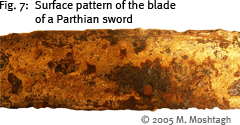 unfullered blades during the Safavid period, they also used a number of other shamshir with fullered blades or blades with raised back edges. A number of swords were signed with gold-inlaid cartouches carrying the names of swordmakers, such as "Amal-e Askari Isfahani" (The work of Askari Isfahani). The research in this book shows that other names, such as Assadollah and Kalbali, which appear on the gold-inlaid cartouches over the centuries should be seen as honorary titles used to signal a high level of mastery in forging reached by the swordsmith. The highest level was, of course, sealed with "Amal-e Assadollah Isfahani" (The work of Assadollah Isfahani). Different decoration methods used on handguards (or "bolchaq"), scabbard fittings ("warband"), handle straps ("ahanak"), and pommel cap ("kolah") are discussed in detail in the book. These decoration methods encompas
unfullered blades during the Safavid period, they also used a number of other shamshir with fullered blades or blades with raised back edges. A number of swords were signed with gold-inlaid cartouches carrying the names of swordmakers, such as "Amal-e Askari Isfahani" (The work of Askari Isfahani). The research in this book shows that other names, such as Assadollah and Kalbali, which appear on the gold-inlaid cartouches over the centuries should be seen as honorary titles used to signal a high level of mastery in forging reached by the swordsmith. The highest level was, of course, sealed with "Amal-e Assadollah Isfahani" (The work of Assadollah Isfahani). Different decoration methods used on handguards (or "bolchaq"), scabbard fittings ("warband"), handle straps ("ahanak"), and pommel cap ("kolah") are discussed in detail in the book. These decoration methods encompas s a wide range of techniques, from flat gold-inlaying "tahneshan", raised gold-inlaying "zarneshan", gold-overlaying "zarkhanest" to chiseling and embossing. Other decorative methods, such as "malilekari" (filigree), and "minakari" (enamelling) for decorating scabbard fittings and handles can also be observed on some pieces. Each one of these decorative techniques is discussed in detail in the book. One important part of this book is an analysis of the meaning and the symbolism of Dhulfaghar, the bifurcated sword attributed to Imam Ali. Based on the lexicon of Dehkhoda, an analysis of artwork, the
s a wide range of techniques, from flat gold-inlaying "tahneshan", raised gold-inlaying "zarneshan", gold-overlaying "zarkhanest" to chiseling and embossing. Other decorative methods, such as "malilekari" (filigree), and "minakari" (enamelling) for decorating scabbard fittings and handles can also be observed on some pieces. Each one of these decorative techniques is discussed in detail in the book. One important part of this book is an analysis of the meaning and the symbolism of Dhulfaghar, the bifurcated sword attributed to Imam Ali. Based on the lexicon of Dehkhoda, an analysis of artwork, the  development of swords, and the double-edged swords attributed to Imam Ali from the Topkapi museum, there is a strong evidence that the bifurcated blades attributed to him came into existence after his own time, carrying the image of Shi’ism (or shi’a). An investigation of the history of double-edged swords shows that these swords were not fully abandoned with the introduction of curved swords, but coexisted with them up to the end of the Qajar period. Beautiful examples of Iranian double edged swords are shown in the book. The book also shows a number of Qajar military swords which were based on European models. The interesting feature of these military swords is that many different patterns of European models, originating from several European countries, were used in their construction.
development of swords, and the double-edged swords attributed to Imam Ali from the Topkapi museum, there is a strong evidence that the bifurcated blades attributed to him came into existence after his own time, carrying the image of Shi’ism (or shi’a). An investigation of the history of double-edged swords shows that these swords were not fully abandoned with the introduction of curved swords, but coexisted with them up to the end of the Qajar period. Beautiful examples of Iranian double edged swords are shown in the book. The book also shows a number of Qajar military swords which were based on European models. The interesting feature of these military swords is that many different patterns of European models, originating from several European countries, were used in their construction.
Other forms of edges weapons such as "qaddare" (single-edged short sword) and "qame" (double-edged short sword) are also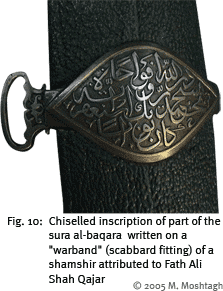 discussed in the book. A number of these weapons are shown in the book, along with an extensive discussion of the different punched stamps of their makers. Although the blades of a number of these weapons were made of plain, carbon steel, beautiful examples of qaddare and qame with wootz blades are also included. One of the most interesting qame is attributed to Abbas Mirza Qajar; this weapon has a pattern welded blade. This specimen is especially interesting because of the rarity of any Iranian-made weapon with the entire blade made out of pattern-welded steel. This unique specimen stands in contrast to other examples, also included in the book, of qaddares with pattern-welded cores, visible only in the fullers, and welded-on carbon-steel edges.
discussed in the book. A number of these weapons are shown in the book, along with an extensive discussion of the different punched stamps of their makers. Although the blades of a number of these weapons were made of plain, carbon steel, beautiful examples of qaddare and qame with wootz blades are also included. One of the most interesting qame is attributed to Abbas Mirza Qajar; this weapon has a pattern welded blade. This specimen is especially interesting because of the rarity of any Iranian-made weapon with the entire blade made out of pattern-welded steel. This unique specimen stands in contrast to other examples, also included in the book, of qaddares with pattern-welded cores, visible only in the fullers, and welded-on carbon-steel edges.
A number of Iranian short weapons such as khanjar (double-edged curved dagger), kard (one-edged knife) and pishqabz (double-curved and one-edged dagger) are 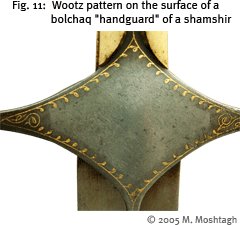 also analyzed in the book. Beautiful examples of khanjar with carved ivory and walrus ivory are pictured. The choice of topics for carving varies from scenes from Shahname, farangizasi (Europeanizing) to even explicit erotic scenes. A number of highly interesting examples of kard are also shown in the book and a classification system of different types of kard is discussed in detail. Many of them show magnificent chiselling "qalamzani" and gold-inlaying in floral design on their blade fortes. One of the rare weapons in the Iranian weapons arsenal is a type of pishqabz which has a double-curved and single-edged blade. Different examples of this weapon are shown in the book and meticulously discussed.
also analyzed in the book. Beautiful examples of khanjar with carved ivory and walrus ivory are pictured. The choice of topics for carving varies from scenes from Shahname, farangizasi (Europeanizing) to even explicit erotic scenes. A number of highly interesting examples of kard are also shown in the book and a classification system of different types of kard is discussed in detail. Many of them show magnificent chiselling "qalamzani" and gold-inlaying in floral design on their blade fortes. One of the rare weapons in the Iranian weapons arsenal is a type of pishqabz which has a double-curved and single-edged blade. Different examples of this weapon are shown in the book and meticulously discussed.
The book also emphasizes the importance of neyze (the spear) in Iranian history. Many bronze spearheads excavated from Marlik and Luristan sites show that spears played an important role as far back as the Bronze Age. The role of spears in the Achaemenian, Parthian and Sassanian periods is also thoroughly examined in the book. Many examples of spears and zubin (javellin), dating from after the Muslim conquest of Iran, are also shown. Different types of gorz (mace), such as globular, pear-shaped and truncheon-shaped maces, knobbed and flanged maces, and animal or human-headed maces are included, as well. The research shows that the "gorz-e gavsar" (bull-headed mace) was
Marlik and Luristan sites show that spears played an important role as far back as the Bronze Age. The role of spears in the Achaemenian, Parthian and Sassanian periods is also thoroughly examined in the book. Many examples of spears and zubin (javellin), dating from after the Muslim conquest of Iran, are also shown. Different types of gorz (mace), such as globular, pear-shaped and truncheon-shaped maces, knobbed and flanged maces, and animal or human-headed maces are included, as well. The research shows that the "gorz-e gavsar" (bull-headed mace) was  already in use during the Bronze Age. Later on, this prestigeous weapon was also mentioned in the epic Shahname, and drawn in many miniatures. During the Qajar period, many bull-headed maces were made as well. The interesting point is that bull-headed maces were used not only as weapons but also as ritual objects in Zoroastrian ceremonies. A discussion of the Tabar (axe) makes up another chapter of the book. Different types of bronze axes from Luristan are shown. Additionally, other archeological examples of axes from different eras in Iran are also presented and discussed. Another chapter deals with the construction of shields; different types of hide shields and steel shields are presented and classified.
already in use during the Bronze Age. Later on, this prestigeous weapon was also mentioned in the epic Shahname, and drawn in many miniatures. During the Qajar period, many bull-headed maces were made as well. The interesting point is that bull-headed maces were used not only as weapons but also as ritual objects in Zoroastrian ceremonies. A discussion of the Tabar (axe) makes up another chapter of the book. Different types of bronze axes from Luristan are shown. Additionally, other archeological examples of axes from different eras in Iran are also presented and discussed. Another chapter deals with the construction of shields; different types of hide shields and steel shields are presented and classified.
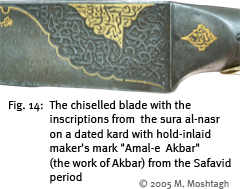
One important part of this book is an analysis of the different types of armor used in the various historical eras in Iran. The differences between scale armor, mail and plate are discussed. 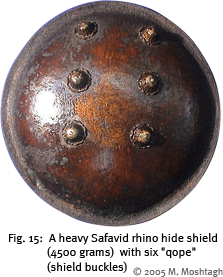 The present book also deals with a detailed analysis of the many different components of Iranian armors, including: joshan and zereh (mail), chahr ayne (four mirrors), bazuband (arm guar), kolah khud (helmet), gariban (standard), zanuband (knee protector), and sagband (shin protector). One chapter of the book contains a detailed description and analysis of the different shapes and types of bows which were used during centuries in Iran. This includes a section of the text dedicated to the making of composite bows, which consisted of wood, horn and sinew. Based on ancient manuals, different types of arrowheads and their related terminology are also discussed in the book.
The present book also deals with a detailed analysis of the many different components of Iranian armors, including: joshan and zereh (mail), chahr ayne (four mirrors), bazuband (arm guar), kolah khud (helmet), gariban (standard), zanuband (knee protector), and sagband (shin protector). One chapter of the book contains a detailed description and analysis of the different shapes and types of bows which were used during centuries in Iran. This includes a section of the text dedicated to the making of composite bows, which consisted of wood, horn and sinew. Based on ancient manuals, different types of arrowheads and their related terminology are also discussed in the book.
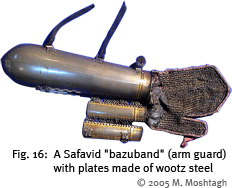
One important element of this work is a historical-cultural analysis of the meaning of the emblem of the lion and the sun  and also the meaning of the emblem of a lion fighting a bull. Different theoretical approaches and interpretations of the meaning of these emblems are given, each accompanied by a detailed historical background. Another important chapter of the book deals with the Iranian warrior tradition. As will be discussed in the book, Iranian warriors followed the rules of jawanmardi, which described the rules of conduct and behavior for warriors. The book also describes the history of ayyaran and explains that the roots of ayyaran go back as far as the Sassanian era.
and also the meaning of the emblem of a lion fighting a bull. Different theoretical approaches and interpretations of the meaning of these emblems are given, each accompanied by a detailed historical background. Another important chapter of the book deals with the Iranian warrior tradition. As will be discussed in the book, Iranian warriors followed the rules of jawanmardi, which described the rules of conduct and behavior for warriors. The book also describes the history of ayyaran and explains that the roots of ayyaran go back as far as the Sassanian era.


The training of warriors is also discussed in the book, such as wrestling, practice tools of varzesh bastani, archery training, handling of the sword, throwing the javelin, horse riding, polo, stickfighting, and playing at the mall. There is also one chapter dealing with different orders of dervishes who carried different weapons, especially axes, during their c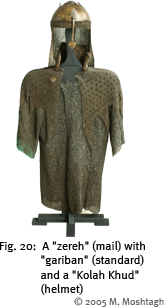 eremonies; the significance of these axes are discussed in detail. An analysis of arms and armor used in naggali (traditional recitation of Shahname) and tazieh (a Shiite passion play) also make up an interesting component of this book.
eremonies; the significance of these axes are discussed in detail. An analysis of arms and armor used in naggali (traditional recitation of Shahname) and tazieh (a Shiite passion play) also make up an interesting component of this book.
Back